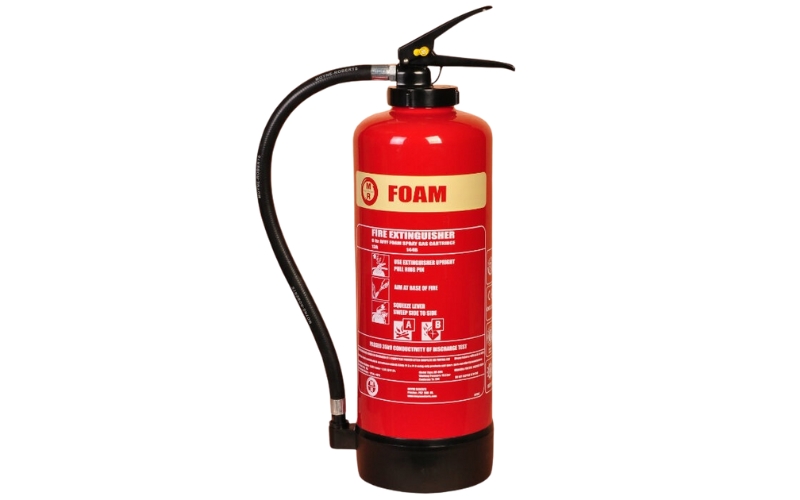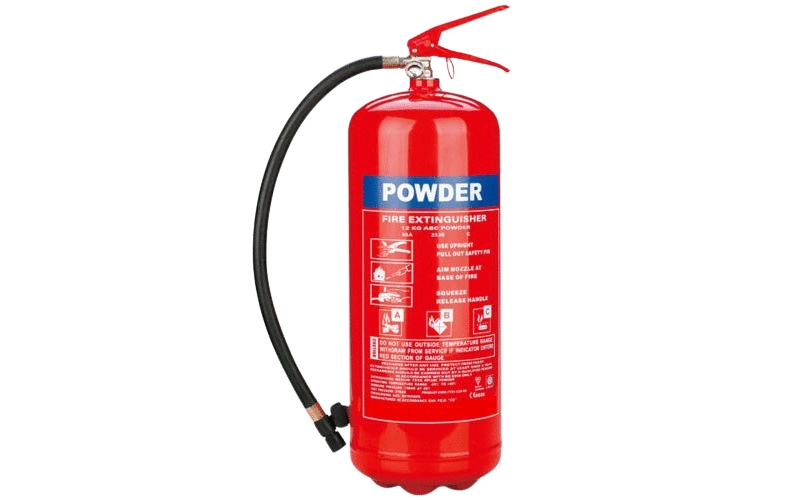This CSCS test revision page covers everything about the Types of Fire Extinguishers. In this CSCS revision note, you’ll learn about various types of fire extinguishers, their colour coding, and their usage in controlling fires on a construction site.
CSCS Revision Notes: Types of Fire Extinguishers
The construction sites are often filled with flammable materials, equipment, and activities that can quickly turn hazardous if proper precautions are not taken. However, it can be minimized by educating workers about fire safety equipment.
Fire Extinguishers
A fire extinguisher is a handheld device that discharges a substance to put out small fires, helping prevent them from spreading. The container of the fire extinguisher is filled with substances that control the fire. They come in various types, each designed for specific kinds of fires.
Types of Fire Extinguishers
Knowledge of various fire extinguishers is essential for passing the Health Safety & Environment (HS&E) test. Here are different fire extinguishers used on construction sites to prevent and control fire:
Carbon Dioxide (CO2) [Colour: Black]

CO2 fire extinguishers are ideal for Class B and electrical fires. They displace oxygen to extinguish flames and are safe for electrical equipment. CO2 extinguishers leave no residue, making them suitable for kitchens, offices, and server rooms. However, they are ineffective in Class A fires.
- CO2 extinguishers are red with a black label to distinguish them from other extinguishers.
- CO2 extinguishers should not be used in confined spaces because lack of oxygen can cause asphyxia.
Water [Colour: Red]

Water fire extinguishers are primarily used for Class A fires involving ordinary combustible materials such as wood, paper, and textiles. They work by cooling the burning material to extinguish the fire. They are unsuitable for fires involving flammable liquids, electrical equipment, or cooking oils, as using water on these fires can be dangerous.
- Water extinguishers are easily identifiable by their solid red colour.
- Water extinguishers are not suitable for electrical and flammable liquid fires.
Foam [Colour: Cream]

Foam extinguishers are effective on both Class A and Class B fires. They are used for fires involving ordinary combustibles like wood and paper and flammable liquids like petrol and paint. The foam creates a barrier separating the fuel from the oxygen, effectively smothering the fire and preventing re-ignition. They are commonly found in environments with a mix of fire risks, such as workshops, garages, and warehouses.
- Foam extinguishers have a cream-coloured label or band for easy identification.
- Foam extinguishers should be avoided in electrical fires because they impose the risk of electrocution.
Dry Powder [Colour: Blue]

Dry powder extinguishers are highly versatile and can be used on Class A, B, and C fires, including ordinary combustibles, flammable liquids, and gases. They work by smothering the fire, effectively cutting off the oxygen supply and stopping the chemical reaction.
- Dry powder extinguishers have blue-coloured labels or bands on red vessels.
- Dry powder extinguishers shouldn’t be used in enclosed spaces.
Wet Chemical [Colour: Yellow]

Wet chemical extinguishers are designed for Class F fires involving cooking oils and fats, making them essential for kitchens and food preparation areas. They work by cooling the fire and forming a thick, soapy layer over the burning oil, which prevents re-ignition by cutting off the oxygen supply.
- Wet chemical extinguishers have yellow-coloured labels or bands on red vessels.
- Wet chemical extinguishers shouldn’t be used on Class B fires, like fires from flammable liquids.
| Fire Extinguisher | CO2 | Water | Foam | Dry Powder | Wet Chemical |
| Colour | Black | Red | Cream | Blue | Yellow |
| Suitable For | Class B Fire | Class A Fire | Class A & B Fire | Class A, B, & C Fire | Class F Fire |
| Unsuitable For | Confined Spaces | Electrical Fire | Electrical Fire | Enclosed Spaces | Flammable Liquids |
Summary
If appearing in the CSCS Health Safety & Environment (HS&E) test, you must know these five main fire extinguisher types and identification signs. Approximately 3 to 5 questions come from this revision note in the final CSCS test. We recommend taking our free online CSCS mock tests to gain confidence.
